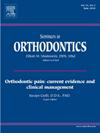Insertion guide for palatal TADs: Advantages and disadvantages from the clinical point of view
IF 2.2
4区 医学
Q2 DENTISTRY, ORAL SURGERY & MEDICINE
引用次数: 0
Abstract
In recent years, there has been a growing trend in orthodontics to use the anterior palatal vault as an insertion site for temporary anchorage devices (TADs), to expand orthodontic possibilities and limit the collateral and unwanted dental effects. To improve accessibility and facilitate the procedure for clinicians, a guided approach for TAD insertion in the palatal vault, using insertion guides, has become increasingly prevalent. The manuscript primarily focuses on the real advantages and possible disadvantages that clinicians can expect when using insertion guides during TAD insertion into the palatal vault. Safety, precise evaluation of insertion depth, and the potential to execute a "one-visit protocol" are examined. Indeed, both direct and indirect palatal insertion protocols result to be efficient and safe in daily practice. The use of insertion guides result to be particularly beneficial for less experienced clinicians as well as for more complex patients and impacted teeth cases. Insertion guides can be created overlapping intraoral scanning to cbct or also to lateral teleradiograph, with sufficient accuracy and lower radiation exposure. However this method is limited in achieving bicortical evaluation, as well as relations to incisive canal and nasal floor. Finally a case report is presented, describing a full digital orthodontic treatment of a young adult patient presenting narrow maxilla. Slow maxillary expansion and fixed orthodontic treatment are described.
腭部 TAD 插入指南:从临床角度看其优缺点
本文章由计算机程序翻译,如有差异,请以英文原文为准。
求助全文
约1分钟内获得全文
求助全文
来源期刊

Seminars in Orthodontics
DENTISTRY, ORAL SURGERY & MEDICINE-
CiteScore
2.20
自引率
4.80%
发文量
28
审稿时长
10 days
期刊介绍:
Each issue provides up-to-date, state-of-the-art information on a single topic in orthodontics. Readers are kept abreast of the latest innovations, research findings, clinical applications and clinical methods. Collection of the issues will provide invaluable reference material for present and future review.
 求助内容:
求助内容: 应助结果提醒方式:
应助结果提醒方式:


